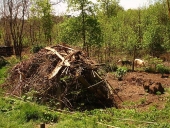Not sure if this is the information that you are asking about but.... I have purchased 110 acres including 30 acres of trees that are reclaiming land all by themselves, about 70 acres of pasture land, 10 acres of reeds and reed grass that used to be a lake. It hasn't been a lake for a long time apparently but it has been unused for about 5 years. Currently we have about 4 feet of grass growing through 5 years of laid over dead grass. Everyone around us has dried up pastures and mine are thriving. As I push my way through the shoulder high grasses (thick and dense) my feet go squish squish in the muck. It seems that left alone my pasture is turning into a lake again. So I would conclude that mulch on pasture would only benefit the pasture as long as it is not overmulched. I should say that my pasture is native grasses that grew there as the lake dissapeared and not seeded hay.
As for the tomato question I tried this experiment a long time ago. After frost I picked all the young tomatoes off, cleared the dead plants to the
compost and tossed the little tomatoes back in the holes left by the tomatoes coming out. Mulch on the garden over winter as usual. In the spring pull back mulch and put in transplants as usual. As I practice crop rotation I was able to readily identify the volunteers. I let any volunteer tomatoes that sprouted grow. The self-seeded tomatoes not only sprouted through the mulch but outgrew and the tomatoes on them were a full two weeks ahead of the ones I had transplanted in (started 6-8 weeks before last frost). I am sure that if I had pulled back the mulch in the spring over where the tomatoes had been left in over winter that they would have sprouted sooner due to warmer soil conditions. Now I just plant my tomatoes where I want them to grow next year and only do transplants of new varieties I want to try.
If of course you have a greenhouse or the space you could start your tomatoes way earlier and get better results from your transplants.





